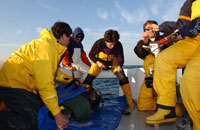
If it swims, flies, walks or climbs, researchers are likely presenting data on its habits and haunts this week at the Third International Biologging Science Symposium. The Tag-A-Giant Foundation and the Tagging of Pacific Predators program are co-hosting the 200+ person meeting at the Asilomar Conference Grounds in Pacific Grove, California.
“Biologging” is the use of electronic sensors, implanted or attached to animals, to track and record their movements, behaviors, physical setting and physiological state in the wild - exactly what TGF does in its electronic tagging research.
Over 130 pioneering researchers from 20 different nations are presenting the most recent findings in this rapidly developing discipline. Symposium sessions focus on advancement of biologging technology, animal behavior, monitoring physiology, climate change, habitat preferences and utilization, and new multi-species observatory networks that take a snapshot of the entire ecosystem. There will also be a special session focused on how biologing data is being applied to conservation and management of wildlife and ecosystems to protect the ocean’s most endangered inhabitants.
The bulk of the presentations will focus on marine life – ranging from whales to penguins to sea otters to swordfish, but studies on a few land animals such as cougars and koalas will be included. Presentations on bluefin tuna include research on all three species - Atlantic, Pacific, and Southern. Several studies partially funded by TGF will be presented: a habitat utilization model for Atlantic bluefin tuna on their Gulf of Mexico spawning grounds, using genetic techniques to differentiate between western and eastern Atlantic bluefin tuna, incorporating tagging data to improve Atlantic bluefin tuna stock assessment models, and habitat preferences of migrating Pacific bluefin tuna.
Other biologging studies that will be highlighted research whether sonar plays a role in mass beachings of beaked whales, or whether captive-bred sea turtles and farmed fish are able to survive in the ocean to the same degree as their counterparts raised in the wild. Another study utilizes tiny accelerometers attached to the jaws of predators to calculate their food intake by measuring the opening and closing of their jaws. Still another uses a 3D version of an accelerometer to record postures and movements of nurse shark courtship and mating.
To read more about the Symposium, including the program and presentation abstracts, please visit http://biologging.wordpress.com/.




No comments:
Post a Comment